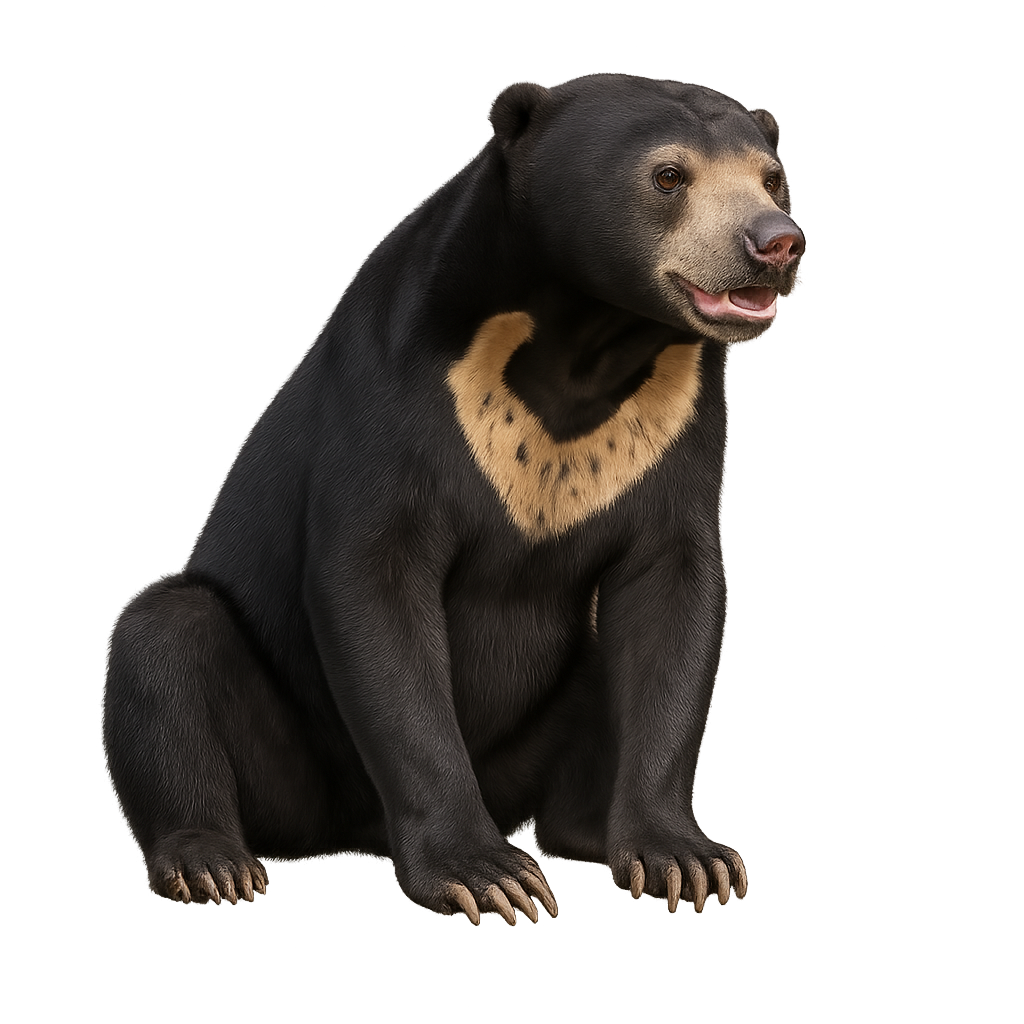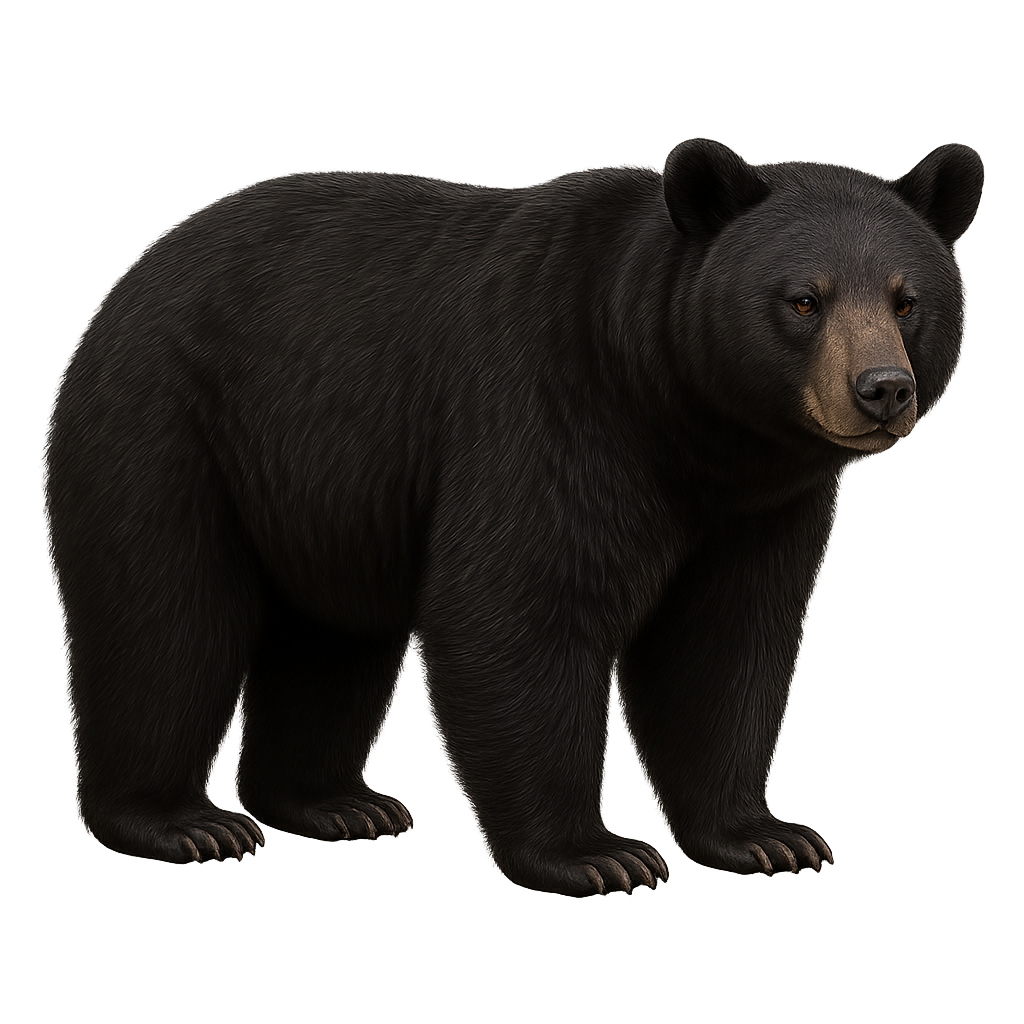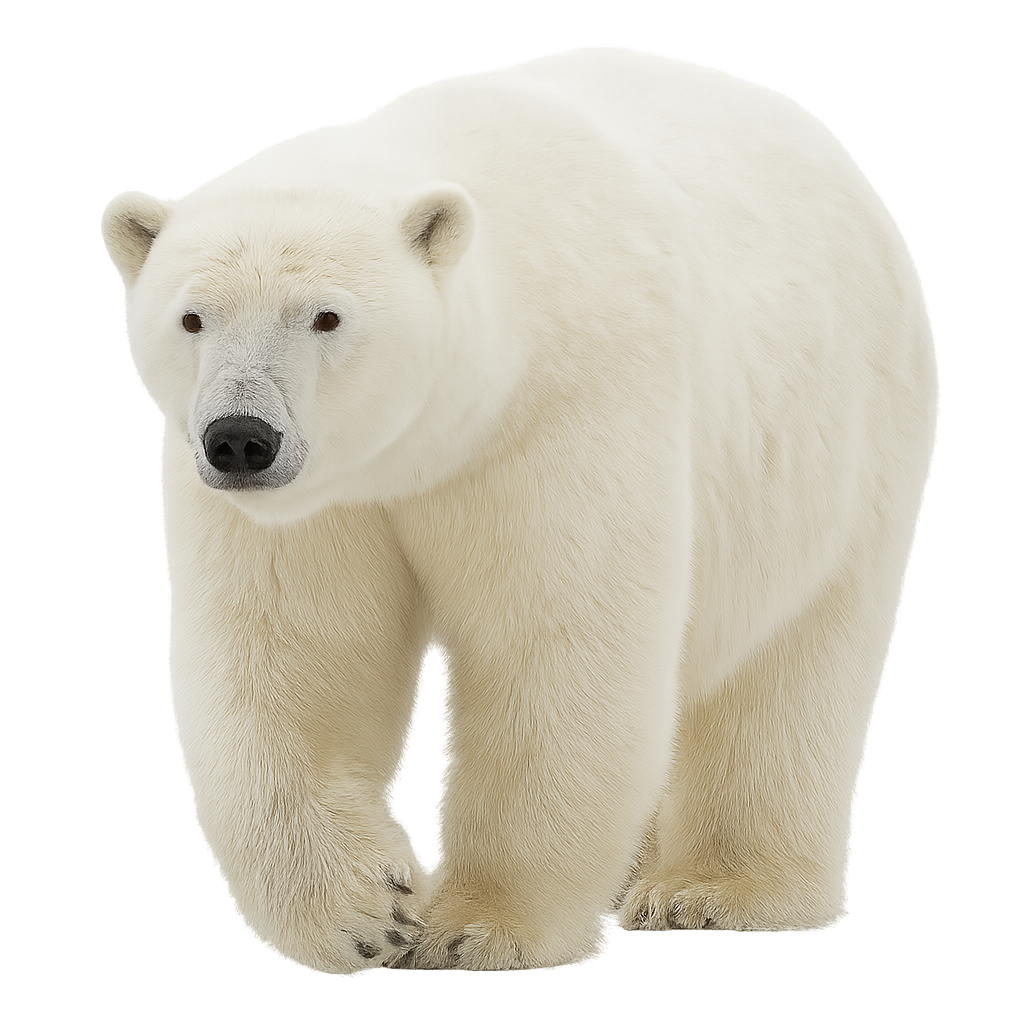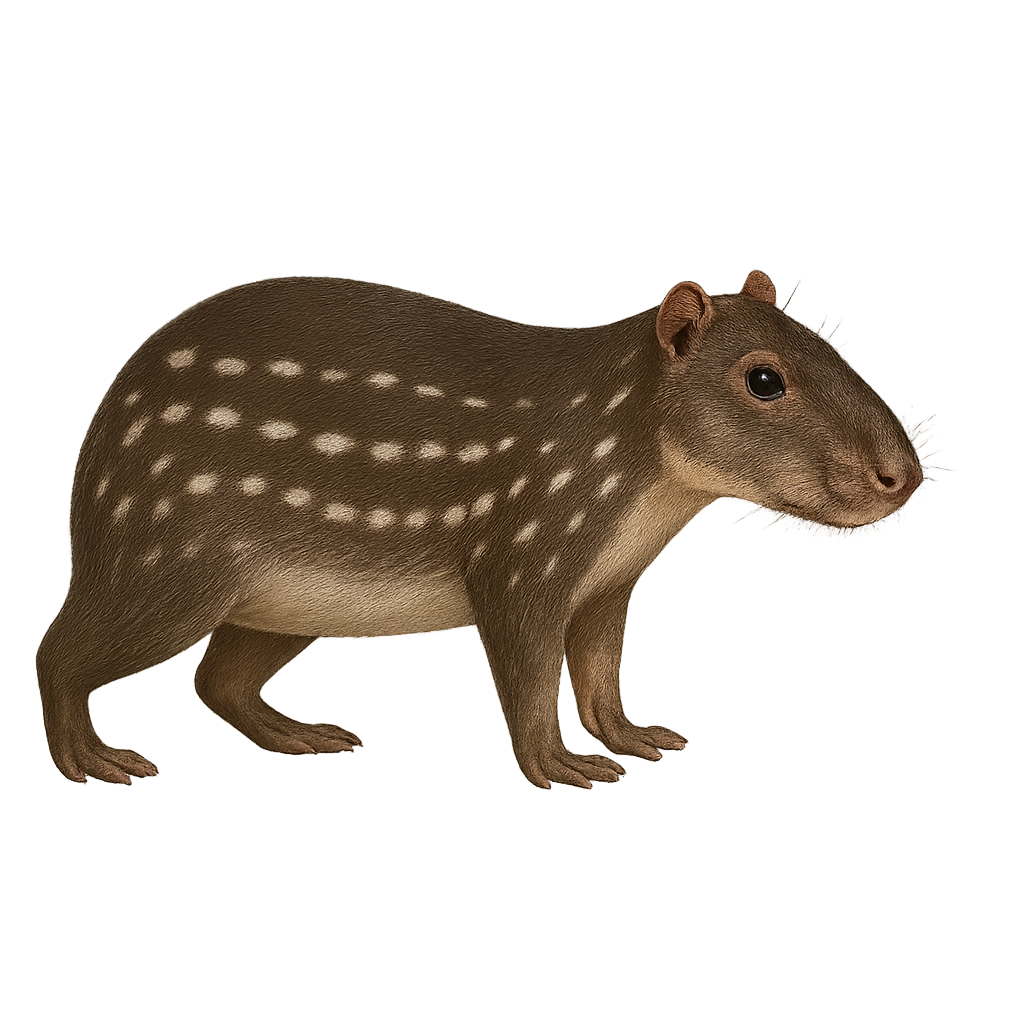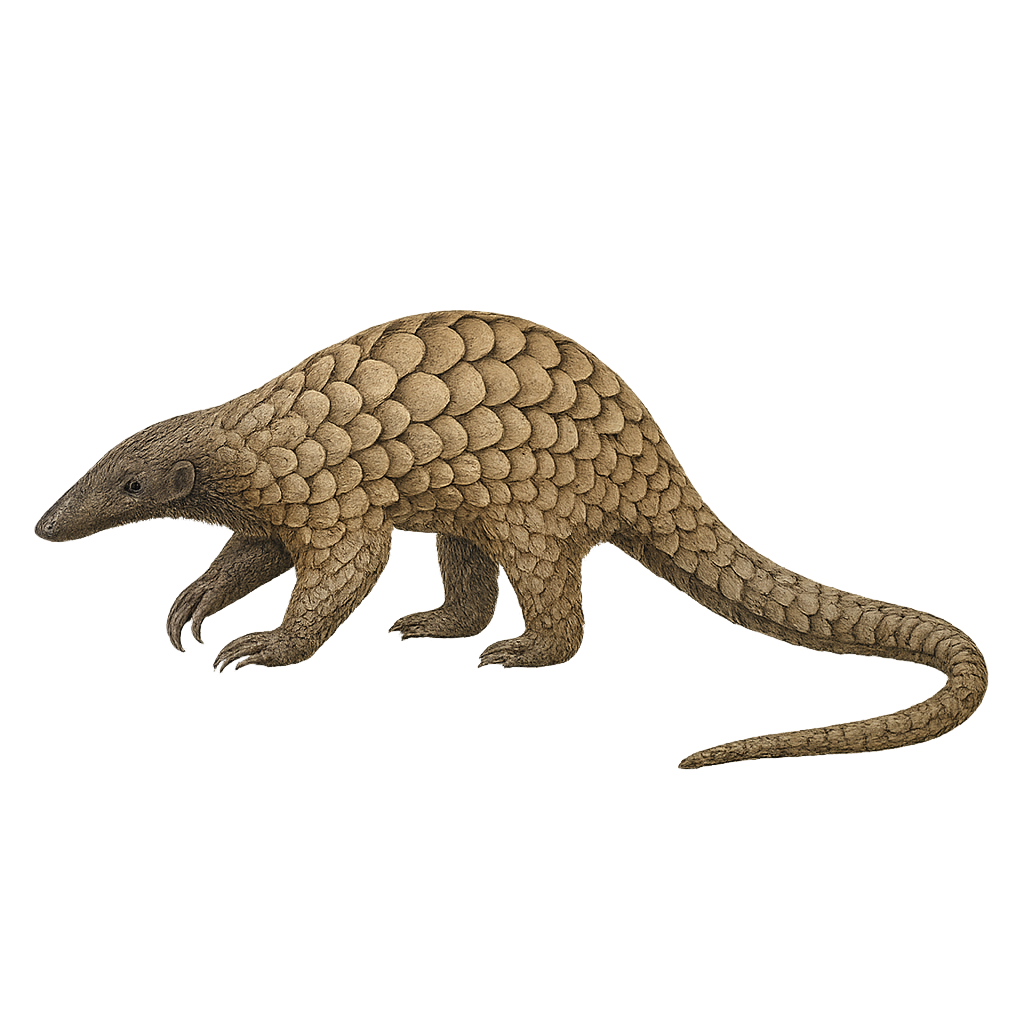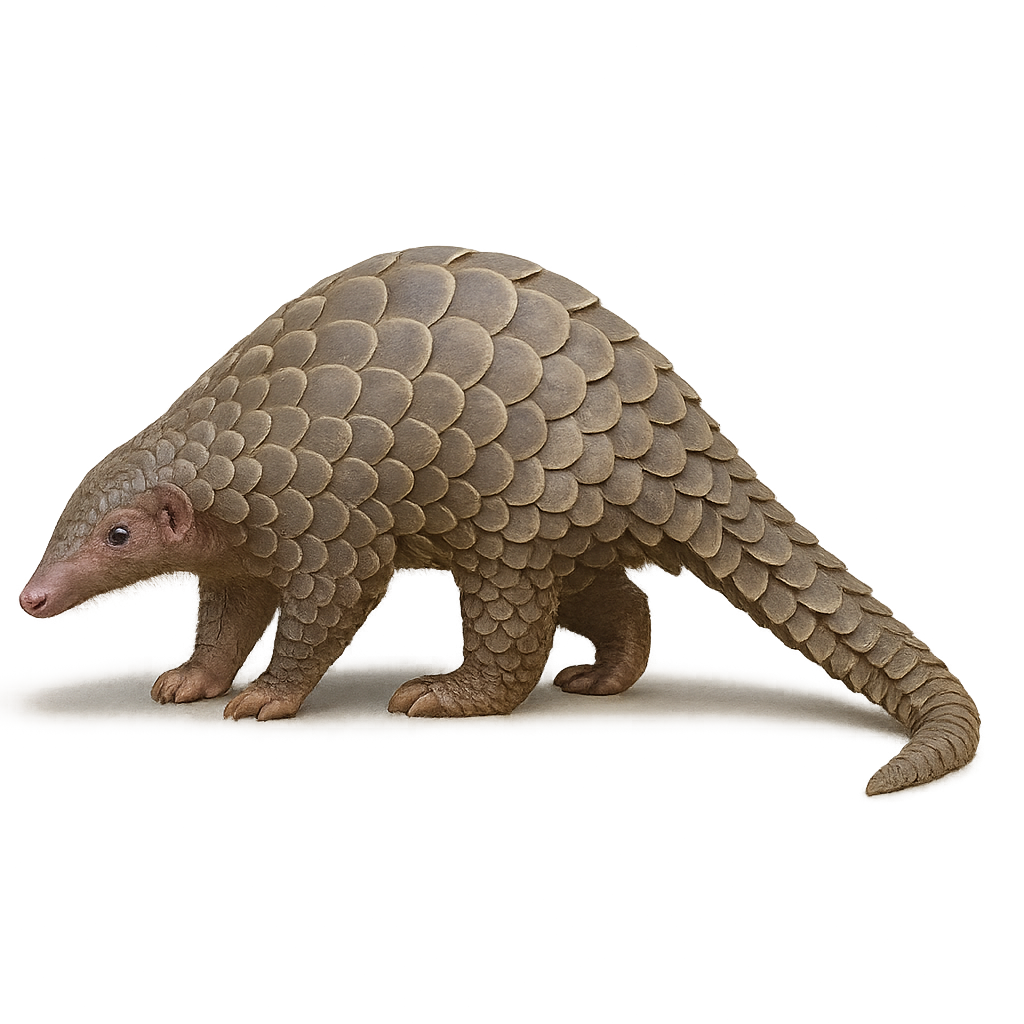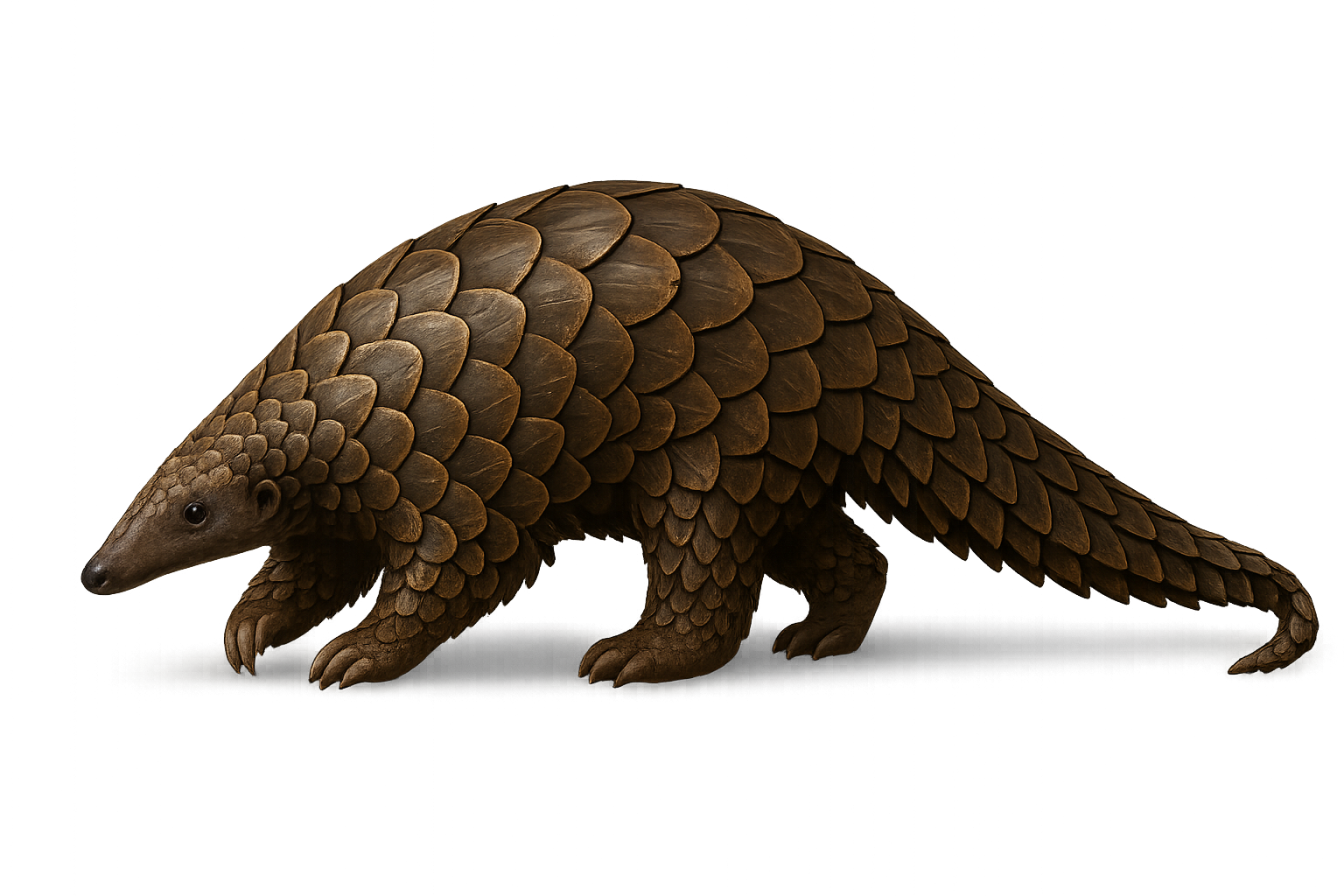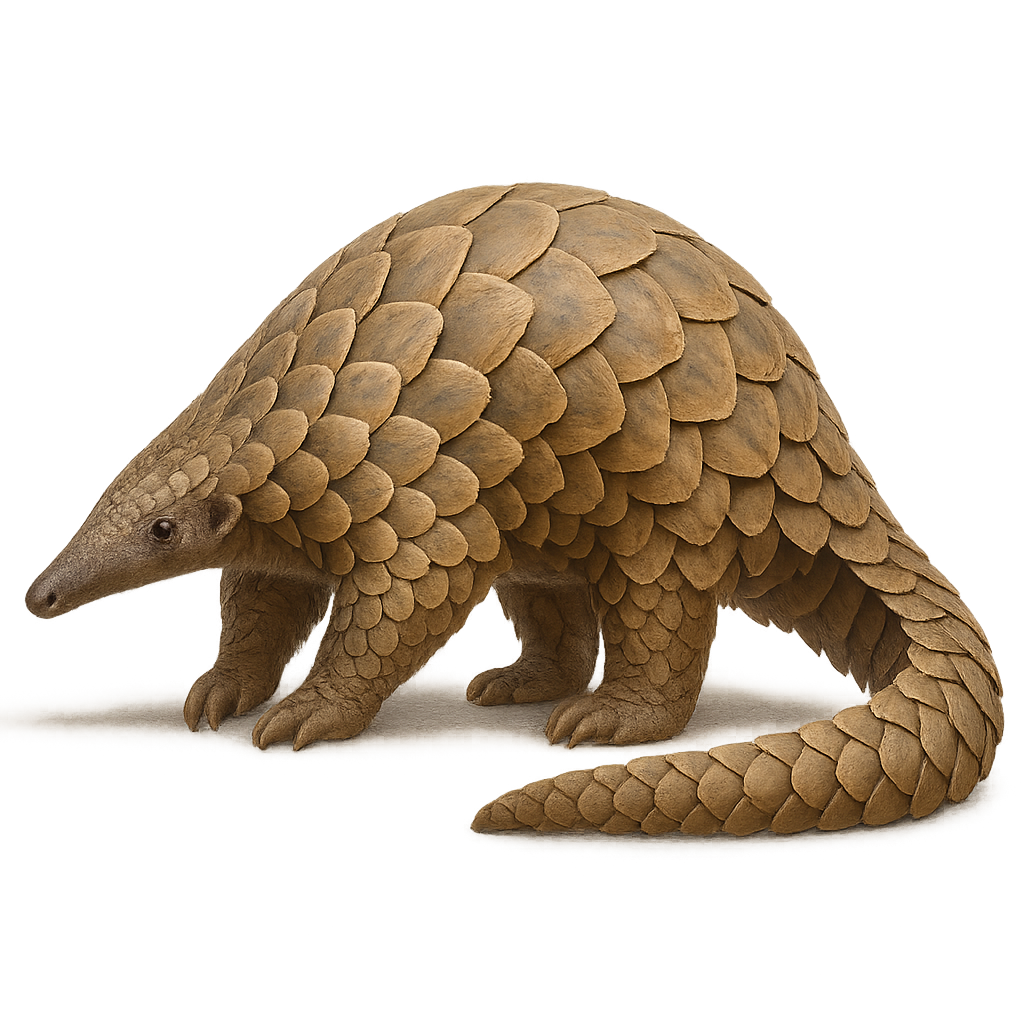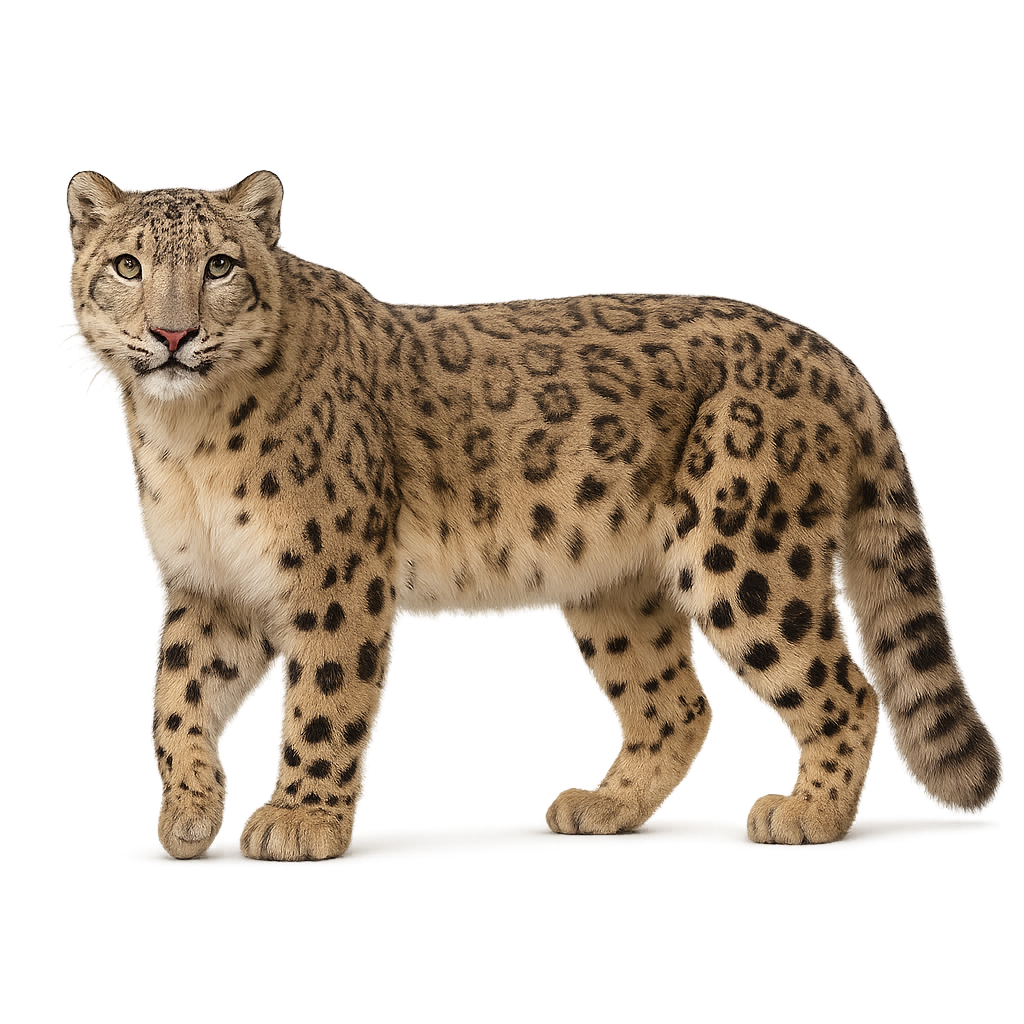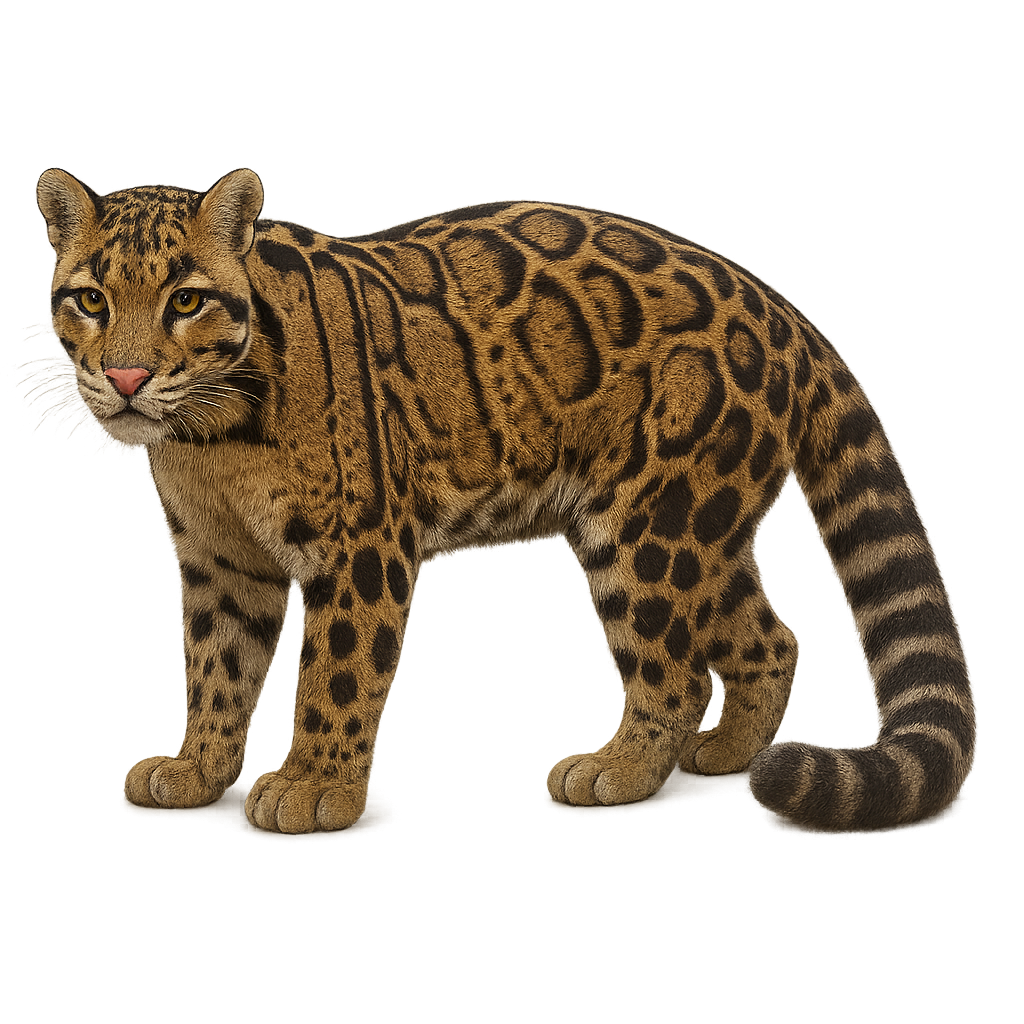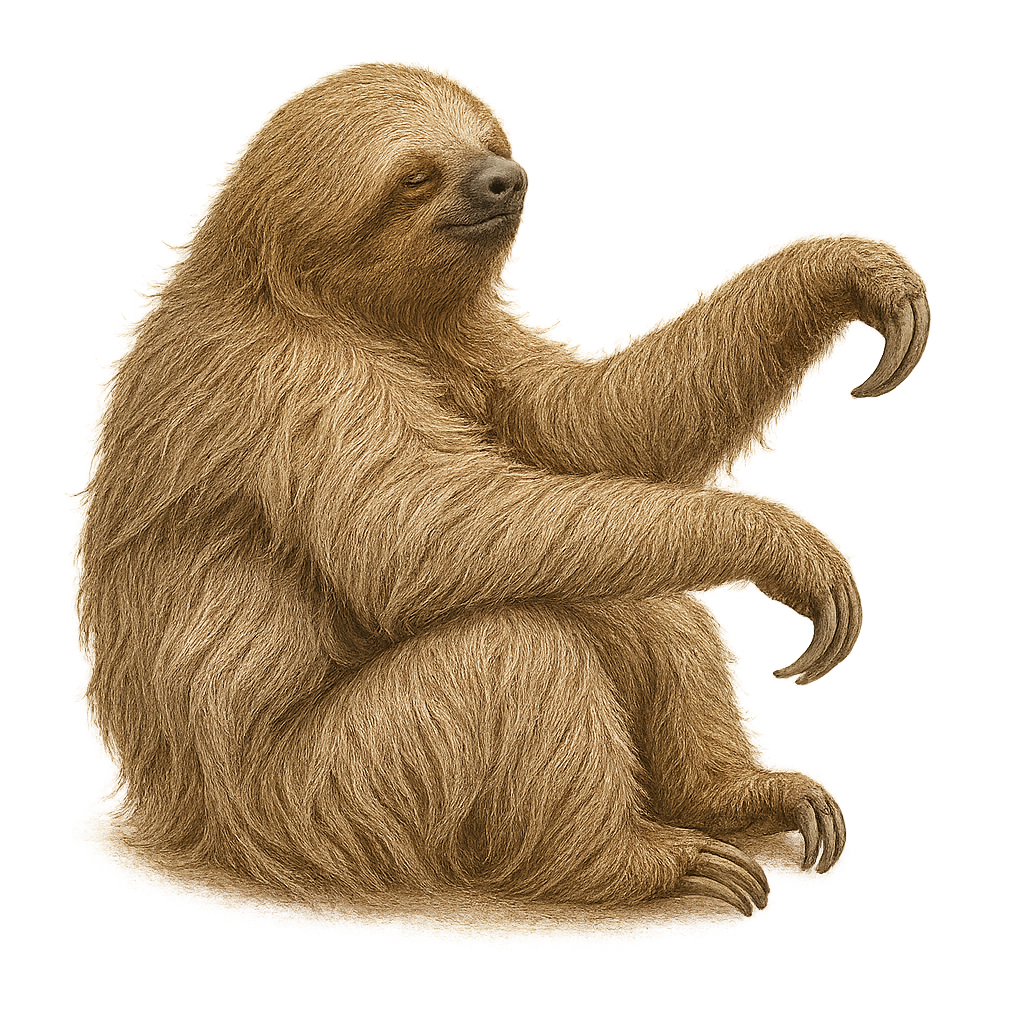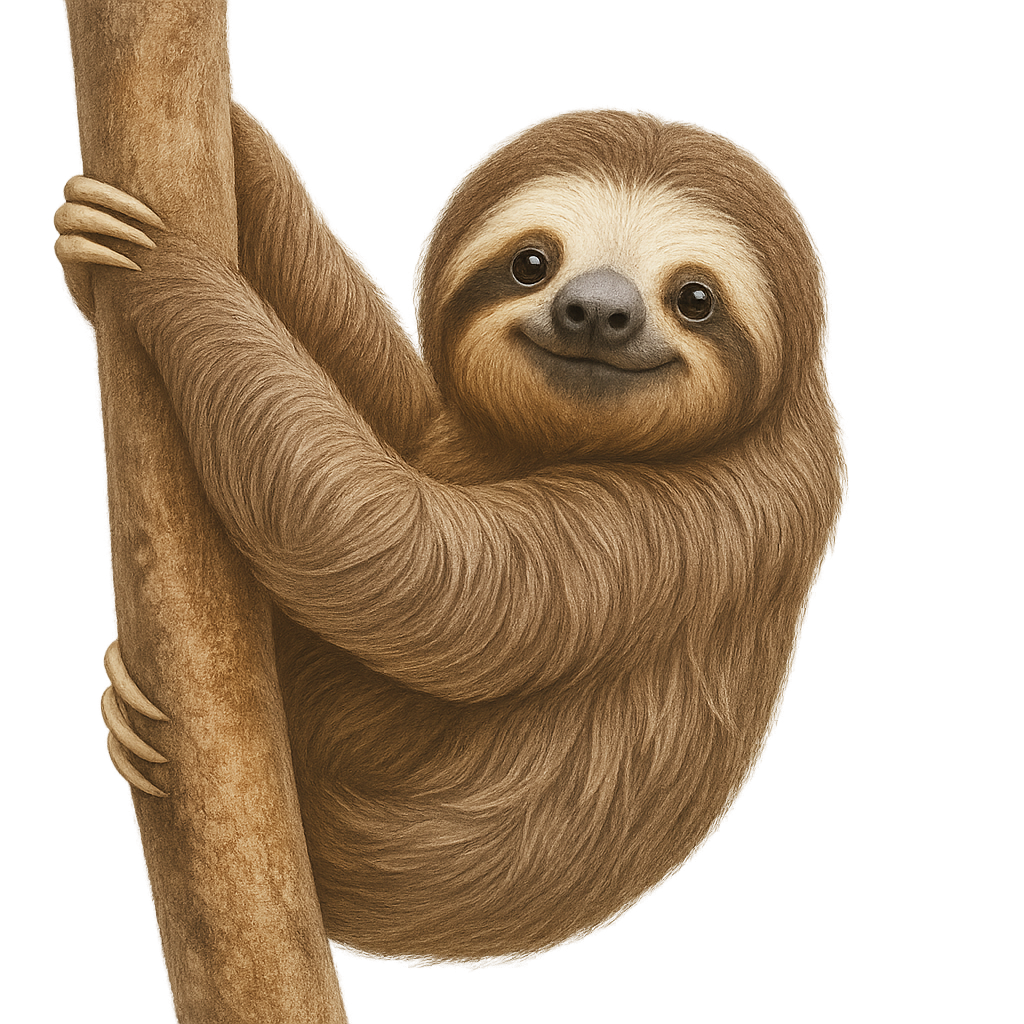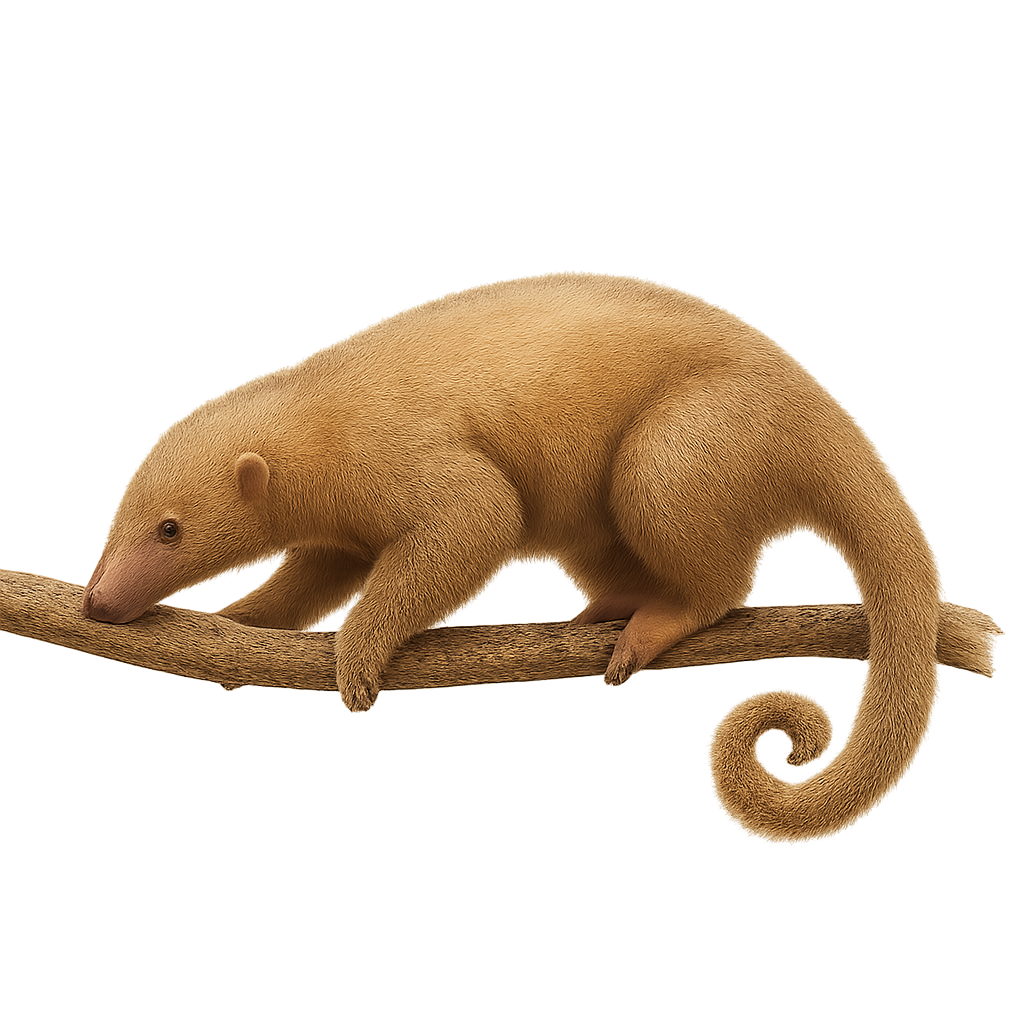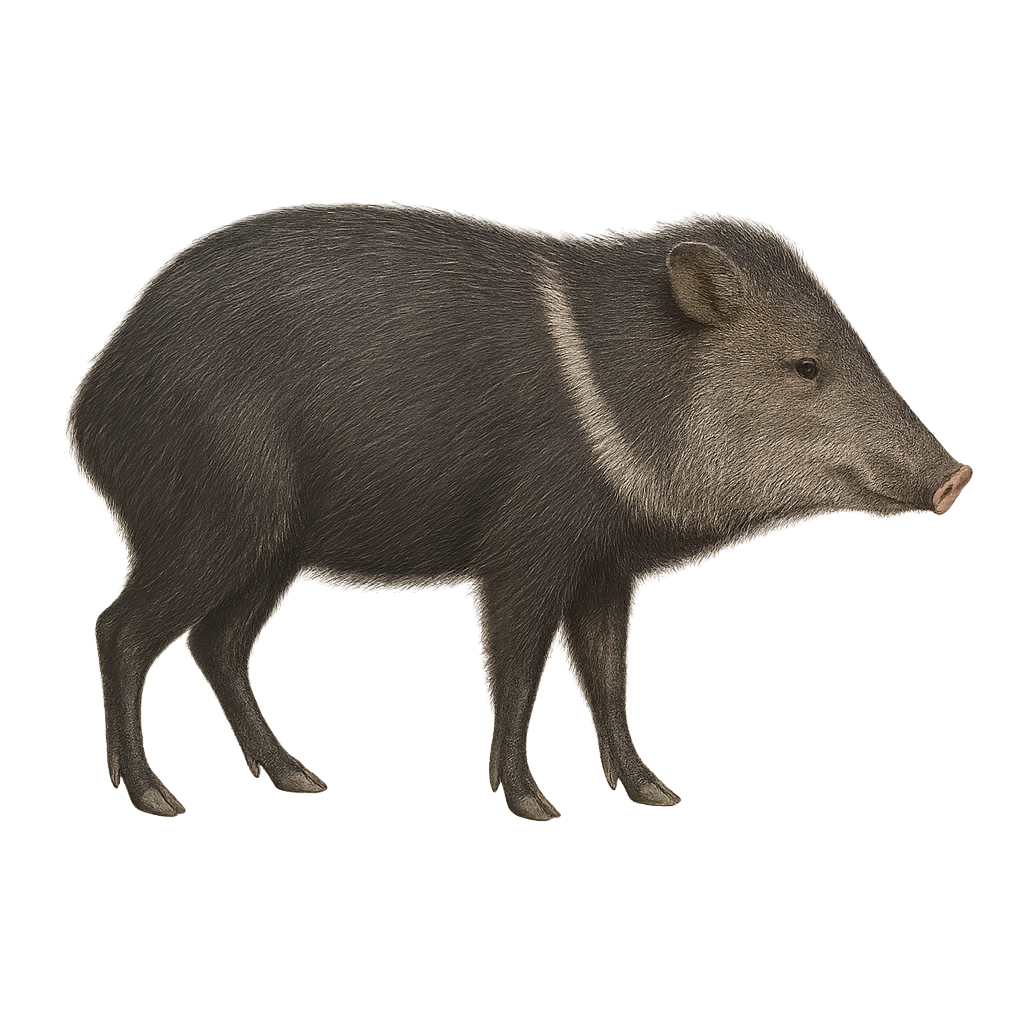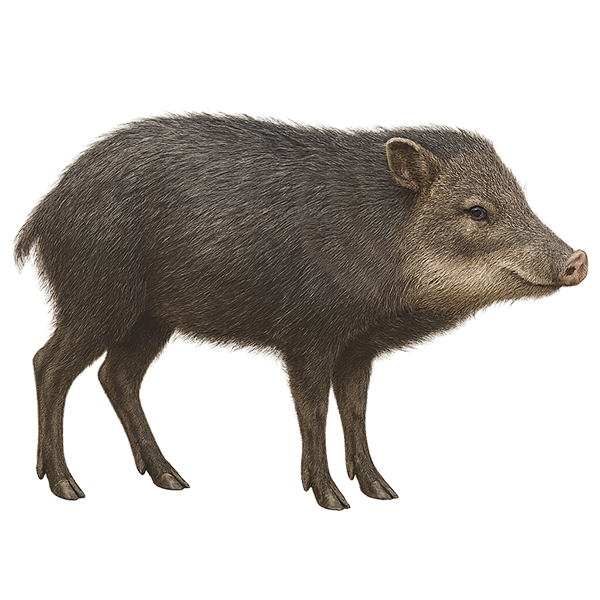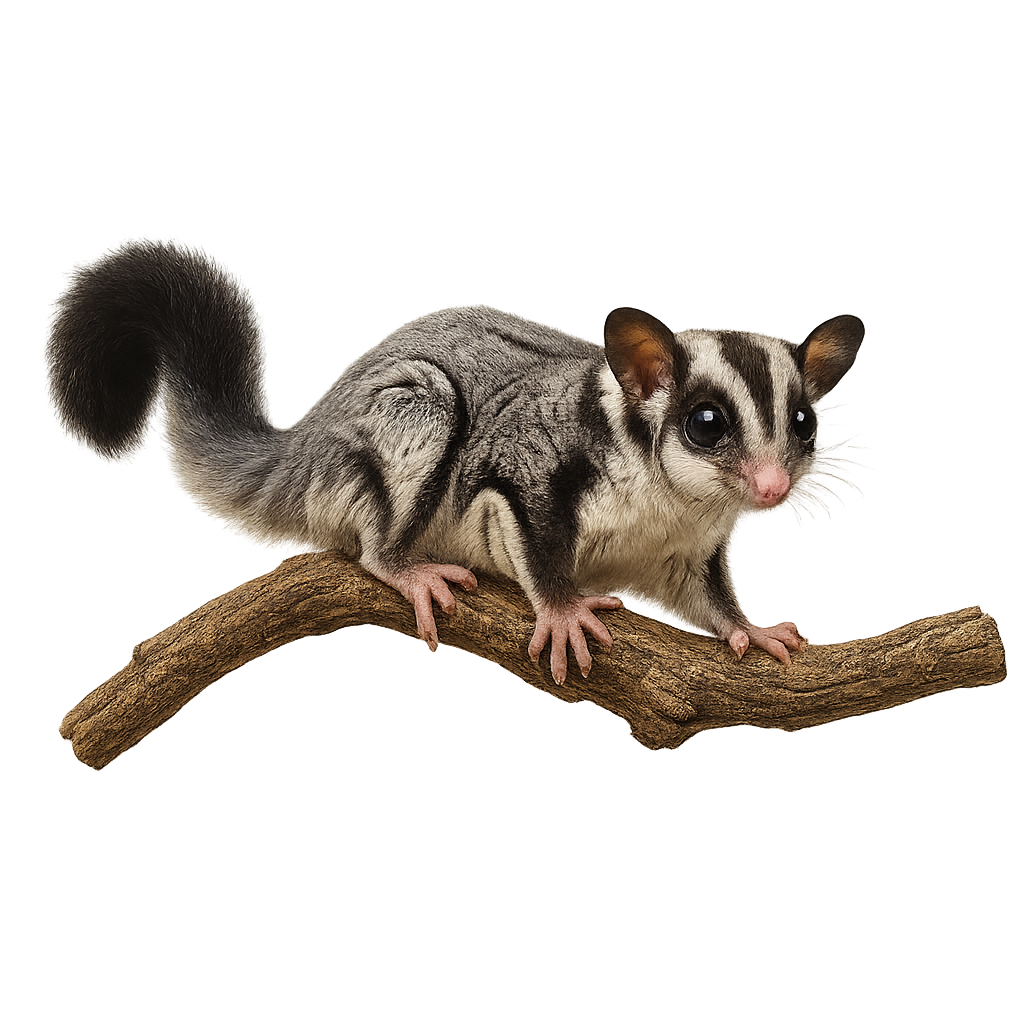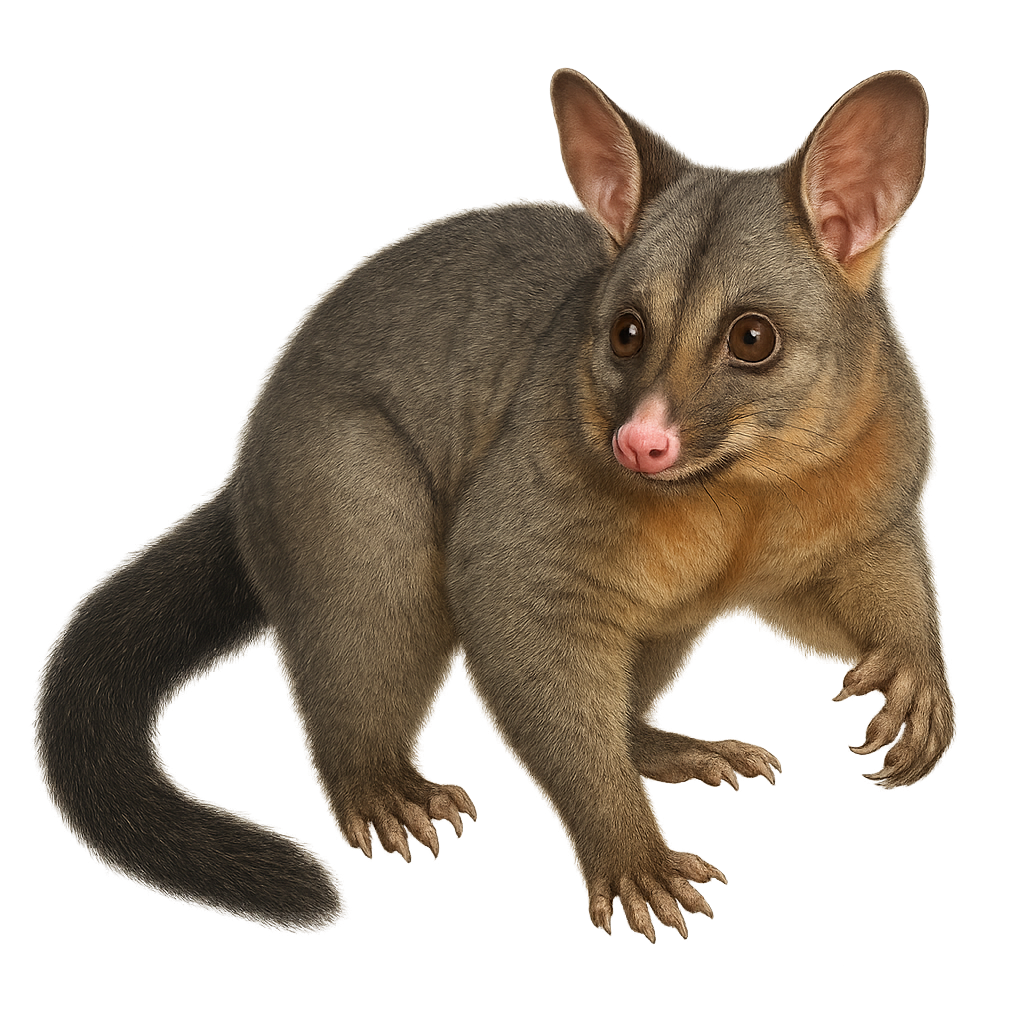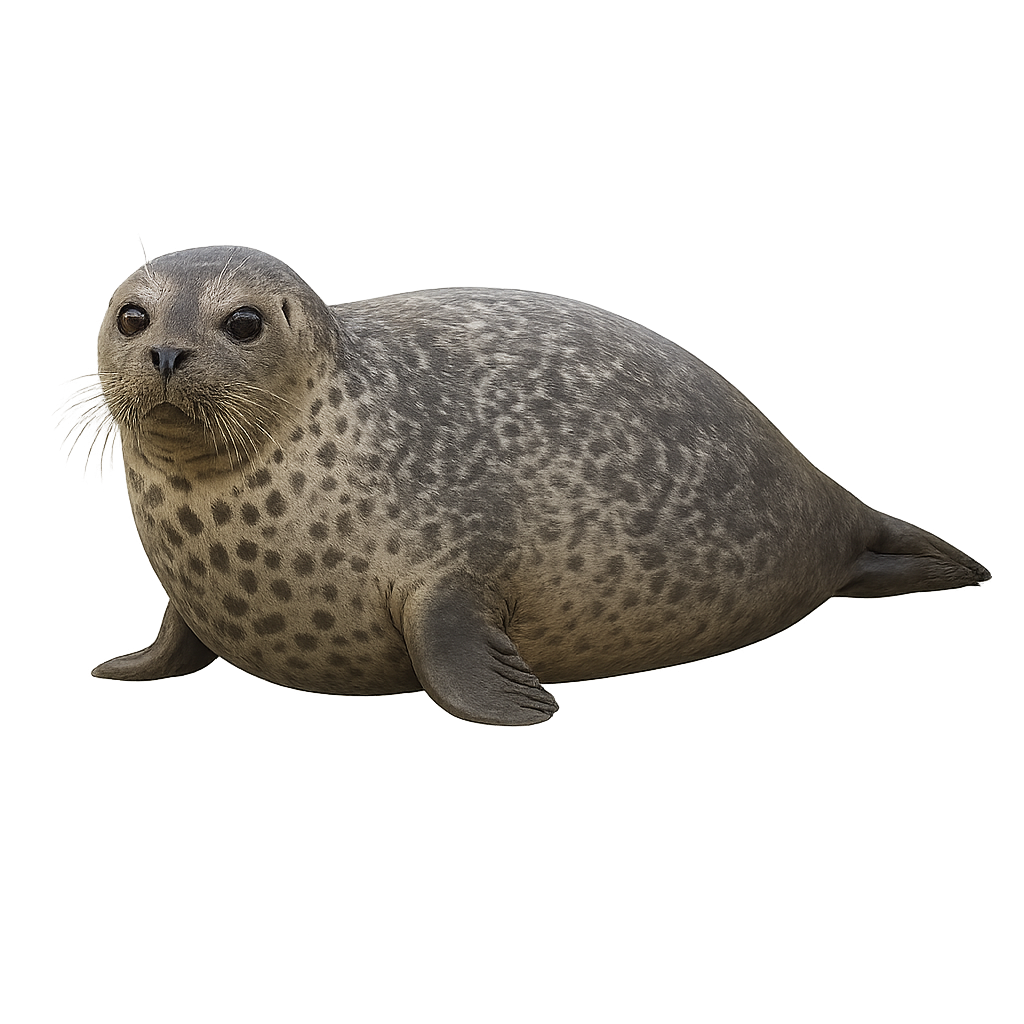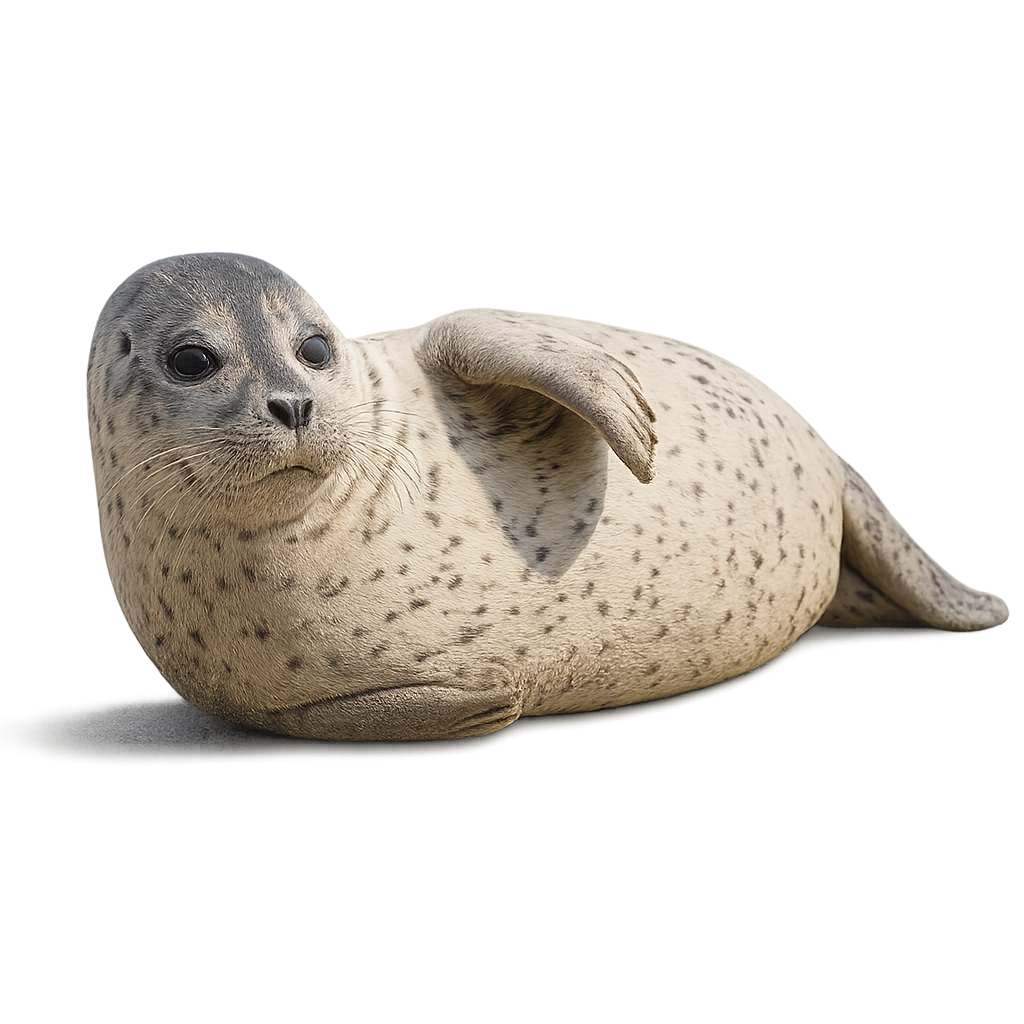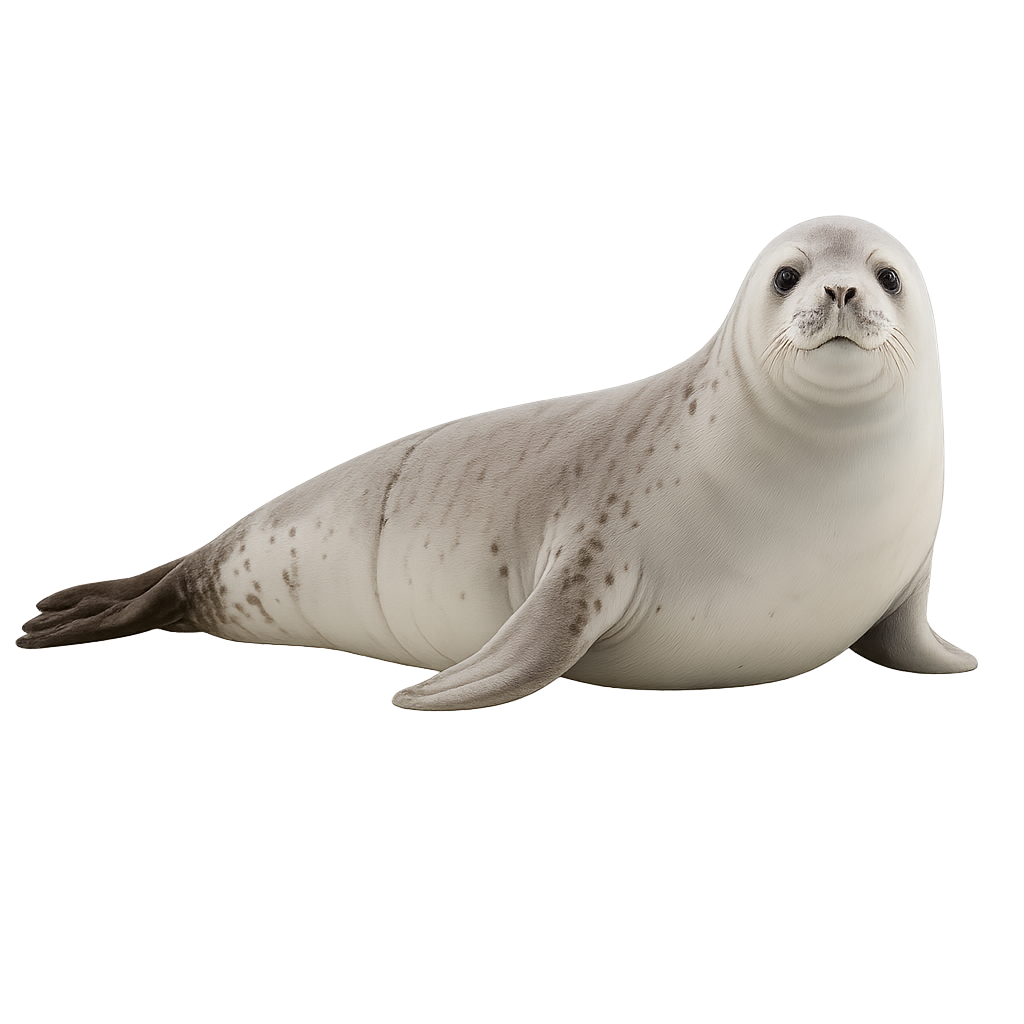The Malayan bear is the smallest of the bears, characterized by its small size, black fur, and a light-colored fur collar around its neck. It primarily lives in the tropical forests of Southeast Asia, where it feeds on fruits, honey, and insects. This animal is rather discreet, nocturnal, and semi-arboreal, often seen in trees looking for food. Although protected, the Malayan bear faces serious threats such as deforestation and illegal hunting.
The American Black Bear is a large carnivore primarily found in North America, in forests, mountains, and wooded areas. It measures between 1.5 and 2.5 meters in length and weighs between 45 and 250 kg, depending on the subspecies and habitat conditions. Its coat ranges from black to light brown, and it has a short muzzle and a large head. The Black Bear is an omnivore, primarily feeding on fruits, berries, nuts, roots, fish, small mammals, and sometimes carrion. It is also an excellent climber and a skilled swimmer, capable of moving through trees and crossing rivers in search of food. While its population remains relatively stable, the Black Bear is threatened by habitat loss, vehicle collisions, and hunting.
The Polar Bear is one of the largest land carnivores, measuring between 2 and 3 meters in length and weighing between 350 and 700 kg, depending on habitat conditions and the season. It is perfectly adapted to the icy conditions of the Arctic, with dense, waterproof fur that protects it from the cold, as well as a layer of subcutaneous fat that helps it survive in extreme temperatures. Its coat is typically white or cream, allowing it to blend in with the snow and ice. The Polar Bear is an excellent swimmer and primarily feeds on seals, which it hunts by patiently waiting near breathing holes or swimming under the ice. However, the Polar Bear faces growing threats due to climate change, which is shrinking its ice habitat and affecting its ability to hunt.
The lowland paca, or Cuniculus paca, is a medium-sized rodent native to the tropical forests of Central and South America. It is easily identifiable by its brown fur with distinct white spots on its sides. Pacas are nocturnal animals that spend the day in burrows dug near water bodies. They are herbivores, primarily feeding on fruits, seeds, and leaves. Their behavior is generally suspicious, making them difficult to observe in the wild. Pacas play a crucial role in seed dispersal, aiding forest regeneration. Their population is stable, although they are sometimes hunted for their meat.
The Giant Panda is a large mammal native to the mountains of China, primarily found in the regions of Sichuan, Shaanxi, and Gansu. It measures between 1.2 and 1.8 meters in length and weighs between 70 and 160 kg. What distinguishes it is its black and white coat, with black patches around its eyes, ears, and paws. The Giant Panda is a strict herbivore, feeding almost exclusively on bamboo, although it may occasionally eat fruits, roots, and small animals. It lives in bamboo forests, where it spends most of its day feeding due to the low nutritional value of its diet. The Giant Panda is a symbol of conservation due to its rarity, and although it is still considered vulnerable, conservation efforts have helped stabilize its population.
The Red Panda, also known as the Lesser Panda, is a small mammal native to the mountains of the Himalayas and southern China. It measures between 50 and 65 cm in length, with a bushy tail of 30 to 50 cm, and weighs between 3 and 6 kg. Its coat is predominantly reddish, with white patches around the eyes, ears, and muzzle. The Red Panda is primarily arboreal, living in temperate and mountainous forests, where it feeds on bamboo, fruits, berries, roots, and occasionally insects. Although it is an excellent climber, it is also active on the ground. The Red Panda is a vulnerable species, primarily threatened by habitat loss, deforestation, and illegal hunting.
The tree pangolin, or Manis tricuspis, is a medium-sized, nocturnal insectivorous mammal found in the tropical forests of Central and West Africa. It is easily recognizable by its protective scales made of keratin, the same substance as human nails. This pangolin is an agile climber, using its prehensile tail to navigate trees in search of ants and termites, its primary food source. Unfortunately, it is threatened by poaching for its meat and scales, which are highly valued in traditional medicine. Conservation efforts are crucial to maintaining the ecological balance of its natural habitat.
The long-tailed pangolin, or Manis tetradactyla, is an insectivorous mammal native to the tropical forests of Central and West Africa. It is easily recognizable by its keratinized scales covering its body, providing protection against predators. This pangolin is particularly adapted to arboreal life thanks to its long prehensile tail, which allows it to move easily through trees. It primarily feeds on ants and termites, which it captures with its long, sticky tongue. Unfortunately, this species is threatened by deforestation and poaching, as its scales are prized in traditional medicine.
The Small-scaled Pangolin is an insectivorous mammal found primarily in Central and West Africa, notably in Cameroon, Gabon, and the Republic of Congo. It measures about 50 to 80 cm in length, with a tail that can reach half its body size, and weighs between 5 and 7 kg. Its body is covered with small, hard scales made of keratin, which protect it from predators. When threatened, the Pangolin curls into a ball, exposing only its scales. It primarily feeds on ants, termites, and larvae, which it captures with its long tongue. Although the Pangolin is an excellent burrower, it is vulnerable due to intensive poaching for its scales and habitat loss. It is currently listed as "vulnerable" by the IUCN.
The Chinese pangolin is a small insectivorous mammal known for its body covered with scale-like plates. Native to China and Southeast Asia, it primarily feeds on ants and termites, which it digs up using its powerful claws. It is an excellent climber, often observed in trees where it seeks shelter from predators. Due to illegal hunting and habitat loss, the Chinese pangolin is critically endangered.
The Javan Pangolin, also known as the Malayan Pangolin, is a mammal species native to Southeast Asia. It is easily recognized by its body covered with large keratin scales, which protect it from predators. This nocturnal and solitary animal primarily feeds on ants and termites, which it captures with its long, sticky tongue. The Javan Pangolin is an endangered species, mainly due to habitat loss and poaching for its scales and meat. This pangolin is an excellent burrower, digging dens and hides for protection.
The Temminck's Pangolin is a small insectivorous mammal found primarily in Sub-Saharan Africa, notably in South Africa, Botswana, Namibia, and Zimbabwe. It measures about 50 to 60 cm in length, with a tail that makes up a significant portion of its size, and weighs between 3 and 7 kg. This pangolin is covered with large scales made of keratin, which protect it from predators. When threatened, it curls into a ball with its scales rolled outward. It primarily feeds on termites and other insects, which it captures with its long, sticky tongue. Although the Temminck's Pangolin is an excellent burrower, it is unfortunately threatened by poaching for its scales and by habitat loss.
The Giant Pangolin is the largest of the pangolin species, measuring between 1.2 and 1.5 meters in length, with a tail that can account for up to half of its total length. It weighs between 30 and 40 kg. This mammal, covered in large keratin scales, primarily lives in the forests of Central Africa, particularly in the Democratic Republic of the Congo and the Republic of the Congo. It is an excellent burrower and primarily feeds on termites and other insects, which it captures with its long tongue. The Giant Pangolin is a nocturnal and solitary species, using its powerful claws to dig burrows or open insect nests. Although its population is not well-known, the Giant Pangolin is threatened by deforestation, illegal hunting, and poaching for its scales, making it a vulnerable species.
The Indian pangolin is a nocturnal insectivorous mammal, 40–65 cm excluding tail, covered in brown keratinous scales with a long prehensile tail. It inhabits forests, scrublands, and agricultural areas of India, Pakistan, and Sri Lanka, feeding primarily on ants and termites with its long sticky tongue. Largely solitary, it digs shallow burrows or shelters in abandoned termite mounds.
The Snow Leopard, also known as the ounce, is a large cat primarily found in the mountains of the Himalayas, Tibet, Central Asia, and the Pamir Mountains. It measures between 1.1 and 1.3 meters in length, with a tail of 80 to 100 cm, and weighs between 27 and 55 kg. Its thick, dense fur, which is light gray to white with dark rosettes, allows it to blend perfectly into its snowy environment. The Snow Leopard is a solitary carnivore, primarily feeding on wild goats, sheep, small deer, and sometimes small mammals. It is an excellent climber and stealthy hunter, capable of pouncing on its prey from high ground. Unfortunately, this species is threatened by illegal hunting, poaching, and habitat loss. It is currently listed as "vulnerable" by the IUCN.
The Clouded Leopard is a medium-sized cat primarily found in the tropical and subtropical forests of Southeast Asia, notably in India, Nepal, Bhutan, Thailand, Malaysia, and Indonesia. It measures between 50 and 75 cm in length, with a tail ranging from 60 to 90 cm, and weighs between 12 and 20 kg. Its coat is characterized by spots and rosette patterns that help it blend perfectly into the dense vegetation of its habitat. The Clouded Leopard is an excellent climber and spends much of its time in trees, hunting birds, squirrels, monkeys, and small deer. Although the Clouded Leopard's population remains relatively stable, it is threatened by habitat loss, poaching, and forest fragmentation. This species is currently listed as "vulnerable" by the IUCN.
The Bornean clouded leopard is a large forest-dwelling cat, measuring 70–110 cm excluding tail, with a distinctive cloud-patterned coat against a pale background. Endemic to Borneo and Sumatra, it inhabits tropical rainforests and cloud forests at low to mid elevations, moving adeptly both on the ground and in the canopy. Solitary and crepuscular, it is an expert hunter of mammals, birds, and reptiles thanks to its strong limbs and tail.
The Choloepus didactylus, commonly known as the Linnaeus's two-toed sloth, is an arboreal mammal native to the tropical forests of South America. It is primarily nocturnal and spends most of its time hanging from tree branches using its strong claws. Its diet mainly consists of leaves, fruits, and flowers. This sloth is known for its slow metabolism and ability to remain motionless for extended periods. Its dense, waterproof fur protects it from the elements and helps it blend into the canopy. Although often solitary, it can sometimes be seen in small family groups.
The Common Sloth is an arboreal mammal native to the tropical forests of Central and South America, particularly in South America, from Costa Rica to Brazil. It measures between 50 and 70 cm in length, with a tail of 4 to 6 cm, and weighs between 4 and 8 kg. Its fur is long and thick, gray-brown in color, with lighter and sometimes greenish patches due to algae growing on its hair. The Common Sloth primarily feeds on leaves, fruits, and flowers, which it eats very slowly. It is known for its extreme slowness, moving at a speed of 0.03 km/h, making it one of the slowest animals in the world. This behavior is due to its slow metabolism and a diet that is low in calories. Although the population of common sloths is not immediately threatened, they are vulnerable to habitat loss and human disturbances.
The Two-toed Sloth is an arboreal mammal native to the tropical forests of Central and South America, notably in Costa Rica, Panama, Colombia, and Ecuador. It measures between 50 and 60 cm in length, with a reduced tail and weighs between 4 and 8 kg. Its fur is long, thick, and gray-green in color, allowing it to blend into the foliage of trees. As its name suggests, it has two toes on its front limbs, which allow it to cling to branches and move slowly from tree to tree. The Two-toed Sloth is primarily herbivorous, feeding on leaves, fruits, and flowers. Although it is an excellent climber, it moves very slowly and often only leaves its trees once a week to descend to the ground for defecation. The species is currently listed as "vulner
The pygmy anteater (Cyclopes didactylus) is a small nocturnal arboreal mammal, measuring 36–45 cm in total length (including a 15–20 cm prehensile tail) and weighing 175–400 g. Its dense, silky golden‐brown fur with subtle darker mottling provides effective camouflage in humid tropical forest canopies of Central and South America. It feeds exclusively on arboreal ants and termites, captured with its long sticky tongue. Breeding occurs year‐round; females give birth to a single young after a 120–150‐day gestation, usually between September and November. Solitary and highly secretive, it shelters in tree crevices or abandoned bird nests and uses harsh calls for communication.
The collared peccary, or Pecari tajacu, is a medium-sized mammal resembling a small wild boar, primarily found in the wooded and semi-arid regions of South and Central America. It is characterized by a band of light-colored fur around its neck, giving it its name. This peccary lives in social groups of up to 20 individuals. It is omnivorous, feeding on fruits, roots, insects, and small vertebrates. Although often hunted for its meat and hide, it plays an important ecological role by dispersing seeds and regulating insect populations. Its ability to adapt to various habitats makes it a resilient species, though it is sometimes threatened by deforestation.
The white-lipped peccary, Tayassu pecari, is a medium-sized mammal belonging to the Tayassuidae family. It is characterized by its dark brown to black fur with a distinctive white band around its mouth. This peccary lives in social groups that can number up to several dozen individuals, which is essential for its survival against predators. It primarily inhabits the dense tropical forests of Central and South America, where it plays a crucial role in the ecosystem by dispersing seeds. An omnivore, it feeds on fruits, roots, insects, and small animals. Unfortunately, this species is threatened by deforestation and excessive hunting, leading to a significant decline in its population.
The Minke Whale is a medium-sized cetacean, a member of the baleen whale family, found in the Atlantic, Pacific, and Southern Oceans. It measures between 7 and 10 meters in length and weighs between 5 and 10 tons. Its body is streamlined, and its color ranges from gray-blue to black, with a lighter belly. This whale primarily feeds on plankton, small fish, and crustaceans, which it filters by swimming with its mouth open. It is an excellent swimmer and can dive to impressive depths for several minutes. While its population remains stable, the Minke Whale is threatened by ocean pollution, ship collisions, and habitat loss due to human impact on marine ecosystems.
The Common Warthog is a wild mammal native to Sub-Saharan Africa. It measures about 1.2 to 1.5 meters in length, with a shoulder height of 60 to 80 cm, and weighs between 50 and 150 kg. It is easily recognizable by its broad face and large curved tusks, which serve as both a defense mechanism and a tool for digging. Its fur is generally gray or light brown, and it has thick, rough skin. The Common Warthog primarily lives in savannas, grasslands, and open forests, where it feeds mainly on roots, fruits, insects, and small animals. It is a social animal, living in groups, and is mainly nocturnal. Although the Common Warthog is widespread and its population is stable, it is sometimes affected by hunting and habitat loss.
The sugar glider, or Petaurus breviceps, is a small arboreal marsupial native to Australia and New Guinea. Known for its ability to glide using a membrane called the patagium, which stretches from its wrists to its ankles, this small animal weighs between 90 and 150 grams. It is primarily nocturnal and feeds on nectar, tree sap, insects, and fruits. Its soft, gray fur with a distinctive black stripe running from its nose to its back makes it easily recognizable. Living in social groups, the sugar glider uses a variety of vocalizations to communicate. Although popular as a pet, it requires specific care to thrive in captivity.
The Trichosurus vulpecula, commonly known as the common brushtail possum, is an arboreal marsupial native to Australia. It has dense, soft fur, usually grey, and a prehensile tail that aids in tree navigation. This nocturnal omnivore feeds on leaves, fruits, flowers, and occasionally insects. Well-adapted to urban environments, it thrives even in human-inhabited areas. The brushtail possum plays an important ecological role as a seed disperser and pollinator. However, it can sometimes be considered a pest due to its feeding habits and adaptation to urban settings.
The Common Seal, also known as the Harbor Seal, is a marine mammal found primarily along the coasts of the North Atlantic, in Europe and North America. It measures between 1.5 and 2 meters in length and weighs between 60 and 150 kg. Its fur is typically light gray with dark spots, and its head is rounded with bright black eyes. The Common Seal is an excellent swimmer and primarily feeds on fish, crustaceans, and mollusks. It is often seen lounging on rocks or beaches. Although its population remains relatively stable, the Common Seal is sometimes threatened by pollution, hunting, and human disturbance of its breeding habitats.
The Pacific Harbor Seal, or Phoca vitulina richardii, is a widely distributed species of seal found in the coastal waters of the northern hemisphere. These marine mammals are recognizable by their spotted coats, which range from gray to brown, and their rounded faces with large whiskers. They typically measure between 1.5 and 1.9 meters in length and weigh between 55 and 170 kg. Pacific Harbor Seal are agile swimmers, capable of diving up to 500 meters to hunt fish, crustaceans, and mollusks. They spend much of their time resting on beaches, sandbanks, or rocks. Although often solitary, they can gather in groups during the breeding season or to rest.
The crabeater seal, Lobodon carcinophaga, is a marine mammal primarily found in the cold waters of Antarctica. It is easily identifiable by its light grey coat, often speckled with darker spots. This seal is well adapted to its icy environment, with a thick layer of blubber that insulates it from the cold. It mainly feeds on krill, which it filters using its specialized teeth. Crabeater seals are often seen in large groups on the ice floes, where they rest and breed. Although they are quite numerous, their population is monitored due to climate changes affecting their natural habitat.


